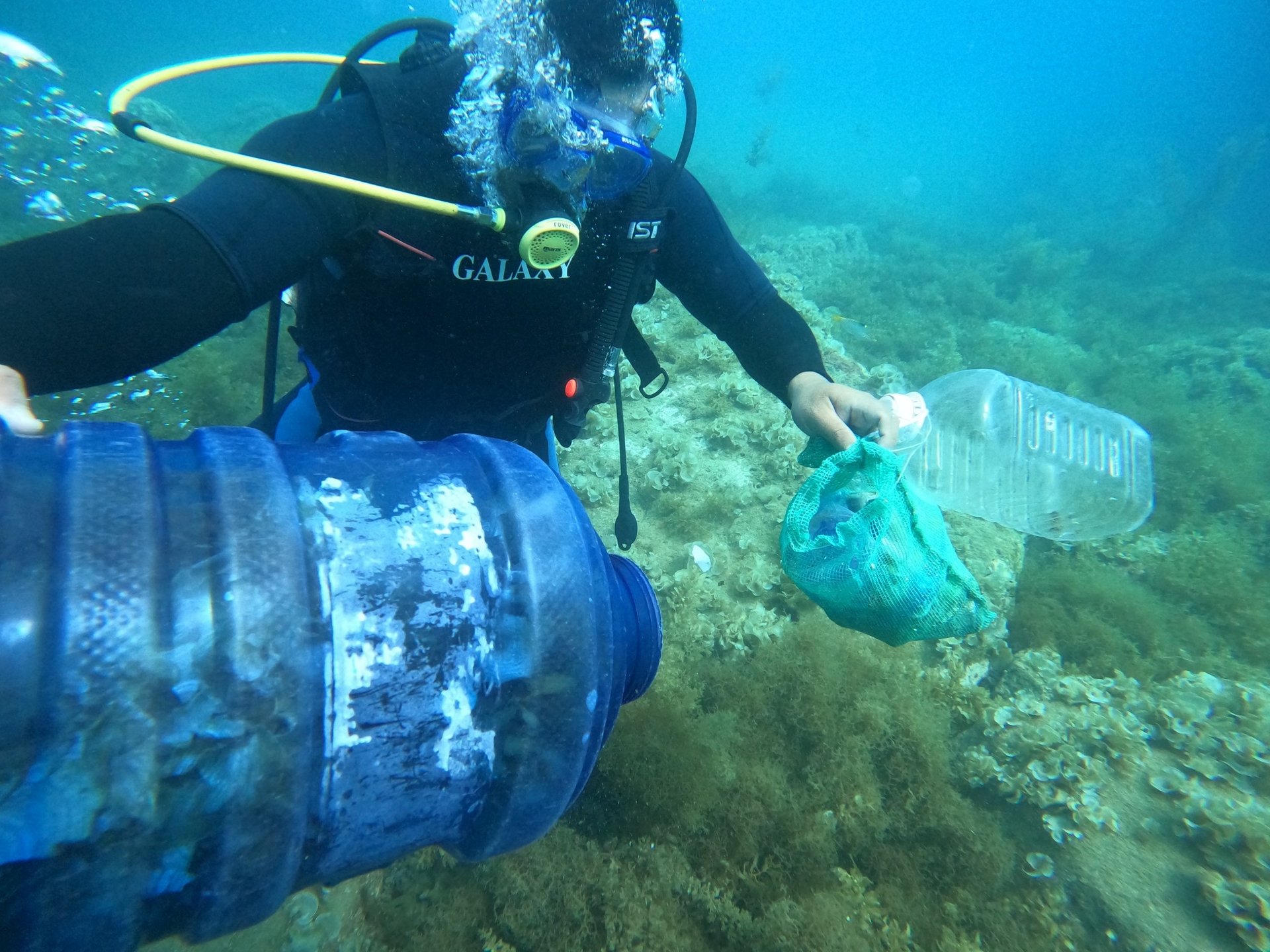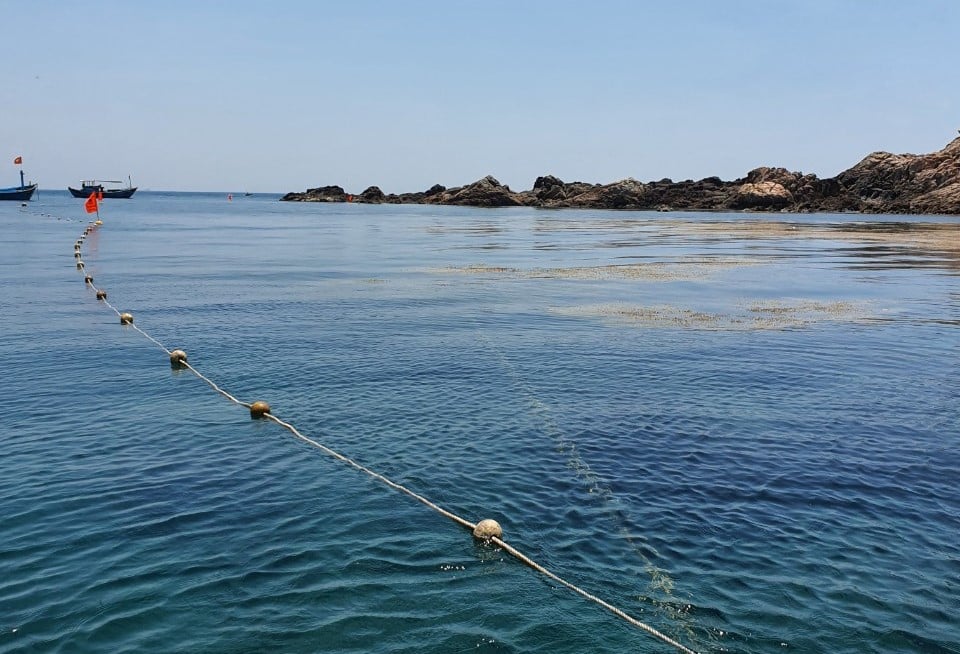June 18, 2025 | 16:34 GMT +7
June 18, 2025 | 16:34 GMT +7
Hotline: 0913.378.918
June 18, 2025 | 16:34 GMT +7
Hotline: 0913.378.918

The Coral Reef Protection Team in Nhon Hai commune, Quy Nhon city, Binh Dinh province, deploying buoys to encircle the core protection area of the coral reefs. Photo: Vu Dinh Thung.
Meet Mr. Nguyen Ton Xuan Sang (born in 1985), a man with nearly 15 years of experience as a "guardian" of coral reefs in the coastal area of Nhon Hai commune in Quy Nhon City, Binh Dinh province.
This "guardian" title can be described as an esteemed profession rather than a salaried one. Being a "guardian" of coral reefs does not come with financial rewards, nor is it an easy task. As a daily activity, these coastal men navigate on small boats in the waters of Hon Kho, which is a small island belonging to Nhon Hai commune in Quy Nhon City, Binh Dinh province, to prevent tourists from trespassing into the core area of the reefs and to provide guidance in snorkeling to admire the coral within the buffer zone. The primary task of these "guardians" is to remind tourists not to discard items such as beer cans, plastic bottles, plastic bags, and nylon bags into the sea, as these types of litter can severely harm the coral reefs. The regular presence of these "coral guardians" also helps deter illegal fishing activities, including the use of explosives and trawling, within areas containing coral reefs. The most rigorously protected areas are the core zones covering an area of more than 12 hectares.
"Thanks to our constant presence in the core zones, we have managed to reduce litter in the area. In addition, we have to deal with waste from fishing vessels, waste carried down from upstream sources, or household waste brought by the waves near the shore of the buffer zones. As a result, our Coral Reef Protection Team maintains sanitation in the core zones as well as the buffer zones," shared Mr. Nguyen Ton Xuan Sang, Director of the Tourism and Aquaculture Service Cooperative and Head of the Coral Reef Protection Team in Nhon Hai commune.

Divers collecting debris from the seabed while protecting the coral. Photo: Vu Dinh Thung.
Starting every March, the Coral Reef Protection Team in Nhon Hai commune prepares vessels to deploy buoys around the core protection area. These buoys are collected by September in the lunar calendar, when the rainy season arrives and the sea becomes rough. According to Mr. Sang, coral reef protection is the responsibility of the Community Resource Management Team in Nhon Hai commune. The team comprises over 50 members, the majority of which are elderly individuals from the community, including two women.
The female members of team are responsible for mobilizing their fellow women in the community. Subsequently, they will warn their husbands, who are fishermen, against disposing of litter into the sea when fishing near the shore and against destructive fishing practices to protect nearshore aquatic resources. The team also emphasizes the importance of preserving the marine environment. The advice of the elderly community members carry significant weight, making their contributions to awareness campaigns highly effective.
Eight skilled young men are responsible for diving to clean the sea floor and protect the coral reefs from litter. Additionally, they eliminate harmful marine creatures that pose a threat to the coral reefs and cultivate beneficial seaweed species that can naturally clean the reefs' living environment.
"Our cooperative can provide two vessels to serve tourists who want to snorkel and admire the coral reefs. Our duty is to prevent them from entering the core zone and guide them around the buffer zone. We charge each snorkeling tourist 10,000 VND per person per trip. We use this amount to support the activities of the community management team and the Coral Reef Protection Team," explained Mr. Nguyen Ton Xuan Sang.

During each cleaning dive within the buffer zone, the coral protection team collects between 30 and 40 kilograms of litter. Photo: Vu Dinh Thung.
With the aim of supporting the Coral Protection Team in their underwater litter cleaning efforts, the Nhon Hai Tourism and Aquaculture Service Cooperative has invested nearly 100 million VND to purchase three more sets of diving tanks in addition to a set of diving air tanks provided by the Coastal Resource Sustainable Development (CRSD) Project in Binh Dinh Province.
The Coral Protection Team in Nhon Hai commune, which consists of eight strong and skilled young men, alternately carries diving air tanks to the seabed every Monday and Friday. They venture into the depths of the sea to collect discarded beer cans, soft drink cans, plastic bottles, nylon bags, fishing nets, and remove Crown-of-Thorns Starfish. Four divers are involved in each cleaning dives. In instances where divers operate in shallow waters at depths of approximately 2 to 2.5 meters, each diving session can last up to one hour before their air supply is depleted. Subsequently, the divers return to the shoreline, carrying nets laden with litter for proper disposal. Conversely, when engaging in dives within deeper waters at depths of approximately 6 to 7 meters, the duration of a single diving session tends to be limited to approximately 45 minutes.
According to Mr. Nguyen Ton Xuan Sang, litter such as beer cans, soft drink cans, nylon bags, plastic bottles, and fishing nets, if not regularly removed, rapidly accumulates on the coral reefs. This accumulation can gradually suffocate the coral reefs, leading to a decline in marine resources.
"During each cleaning dive session within the buffer zone, we collect between 30 and 40 kilograms of litter. There is less litter in the core zone, so we collect between 1 and 2 kilograms per dive. On an yearly average, the divers from the Coral Protection Team collects between 15 and 20 kilograms of various types of litter per cleaning dive. On the other hand, Crown-of-Thorns Starfish, if not removed regularly, can cause even more harm to the coral reefs. Coral is one of Crown-of-Thorns Starfish's preferred diet, and they will feed on the coral until the reefs turns white," shared Mr. Nguyen Ton Xuan Sang.
According to Mr. Sang, an abundance of Crown-of-Thorns Starfish can found on the seabed of thriving coral reefs. Additionally, the diameter of this Starfish can reach half a meter when they fully grow. The Coral Protection Team in Nhon Hai commune primarily hunts for Crown-of-Thorns Starfish with a diameter of around 20 centimeters.
"Coral is easy to spot because of its vibrant colors; it stands out amidst the green of seaweed. When we dive, we can immediately identify its presence. If we see coral bleaching, we know that the area is heavily infested with Crown-of-Thorns Starfish because this Starfish causes coral death faster than any other types of litter," Mr. Sang explained.

Buoys encircle the coral reef zones in the Nhon Hai sea, Quy Nhon city, Binh Dinh province. Photo: Vu Dinh Thung.
The Coral Protection Team in Nhon Hai commune removes an average of 100 Crown-of-Thorns Starfish per year. These removed starfish are transported to a designated burial site on the island for disposal. Despite their relentless efforts in removing Crown-of-Thorns Starfish, the recurrent appearance of these creatures on the seabed have led the Coral Protection Team to suspect that these starfish were released by the crashing waves tthat disturbed the layer of sand covering the burial pit.
"I believe that the sea waves wash away the sand layer covering the burial pit when they hit the shore, allowing the Crown-of-Thorns Starfish to escape and be carried back into the sea, where they could regenerate. In recent years, we transported the removed starfish to a landfill located on Long My Mountain in Quy Nhon City, Binh Dinh province to surprising effectiveness. The population of Crown-of-Thorns Starfish in the waters of Nhon Hai commune has decreased substantially since the implementation of this solution," shared Mr. Nguyen Ton Xuan Sang.
According to Mr. Tran Van Vinh, Deputy Director of Binh Dinh province's Sub-Department of Fisheries, the province has established 11 community-managed models for the protection of aquatic resources in 20 coastal communes and wards, involving approximately 500 participants since late 2018. Accordingly, three most exemplary models include the Tra O Lagoon community-managed model, the North Thi Nai Lagoon area, and the Quy Nhon Bay area.
"Under the United Nations Development Program, the Canadian government will sponsor 1.75 million Canadian dollars, or approximately 27 billion VND, for Binh Dinh province to develop projects pertaining to climate change, biodiversity conservation, and gender equality issues within four years. Accordingly, the Binh Dinh province's agricultural sector proposed the establishment of a Quy Nhon Bay marine conservation area and the restoration of 4 hectares of coral reefs in this bay, which are located in the territories of four communes and wards including Nhon Ly, Nhon Hai, Nhon Chau, and Ghenh Rang," said Mr. Tran Van Phuc, Director of the Binh Dinh province's Department of Agriculture and Rural Development.
Translated by Nguyen Hai Long
![Turning wind and rain into action: [9] Digitizing hydrometeorological data in response to climate change](https://t.ex-cdn.com/nongnghiepmoitruong.vn/608w/files/news/2025/06/17/z6704423696987_15fd32ffc26d590d204d520c9dac6786-nongnghiep-165943.jpg)
(VAN) Farmers have begun accessing hydrometeorological applications to adjust their cropping schedules, aiming to ensure productivity and adapt to climate change.
![Turning wind and rain into action: [8] Real-time salinity detection and early warning technology](https://t.ex-cdn.com/nongnghiepmoitruong.vn/608w/files/news/2025/06/17/z6704423696987_15fd32ffc26d590d204d520c9dac6786-nongnghiep-151127.jpg)
(VAN) Thanks to the integration of modern hydrological-hydraulic models, remote sensing technologies, and artificial intelligence, the accuracy of hydrological forecasting has significantly improved.
![Turning wind and rain into action: [7] Early disaster warnings help marine farmers minimize losses](https://t.ex-cdn.com/nongnghiepmoitruong.vn/608w/files/news/2025/06/17/z6704423696987_15fd32ffc26d590d204d520c9dac6786-nongnghiep-142942.jpg)
(VAN) In recent years, thanks to early disaster warnings and forecasting, marine farmers in Khanh Hoa province have been able to reduce risks and losses, thereby improving production efficiency.
![Turning wind and rain into action: [6] ‘Four on-the-spot’ disaster management software](https://t.ex-cdn.com/nongnghiepmoitruong.vn/608w/files/news/2025/06/17/e5a48259d6a262fc3bb3-nongnghiep-183800.jpg)
(VAN) By simply activating the scenario on the disaster management software, the relevant authorities immediately know how many households need to be evacuated, where to evacuate them to, and by what means of transportation…
![Turning wind and rain into action: [5] Hue applies modern technology in disaster forecasting](https://t.ex-cdn.com/nongnghiepmoitruong.vn/608w/files/news/2025/06/17/z6704423696987_15fd32ffc26d590d204d520c9dac6786-nongnghiep-093938.jpg)
(VAN) In Hue city, modern technology has recently been applied in meteorological and hydrological forecasting and warning, helping to reduce the damage caused by natural disasters.

(VAN) A cutting-edge farming technique being implemented on an experimental ranch in Arizona's Sonoran Desert has already saved a billion gallons of water over five years, according to Civil Eats.

(VAN) Poultry and pig production and the environment can be boosted through enhanced water technology, according to new research.